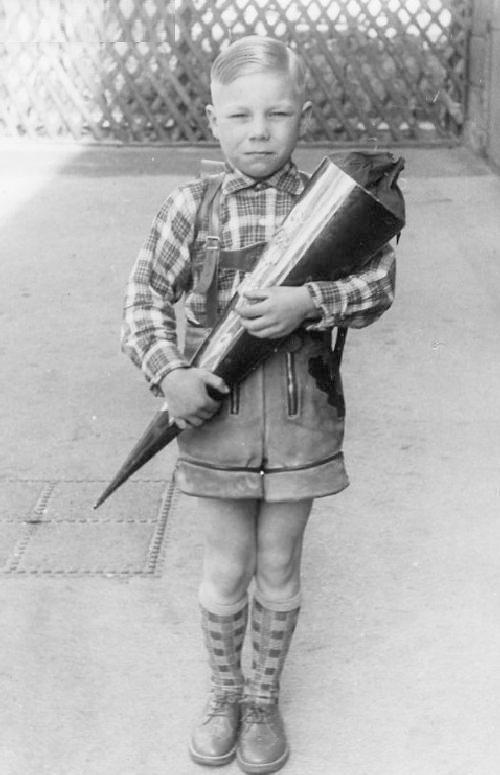
Figure 1.--Here a little 6-year old German boy is off to his first day of school in 1956. He is wearing a brand new pair of Lederhosen. Notice the flaps that can be turned down when he is a liitle older, Also notice the plaid shirt. |

|
We see many German boys wearing Lederhosen to school during the photographic record. It is does become much more common to wear Lederhosen to school in the 1950s, probably because of the vastly improved economic conditions. The prevalence is a little dificult to assess in class portraits because quite a number of boys wore H-bar shorts or even halters, but not necessarily with proper leather short Lederhosen. And some older boys did not wear the haters. Lederhosen were particularly common at primary schools. We note some boys weaing Lederhosen for their first day portraits. A good example is an unidentified boy in 1957.
Often a few boys in many primary schools are wearing lederhosen by the 1950s. We see boys of all ages wearing Lederhosen to school in the 1950s, both younger and older boys. One example of what looks like a younger teenager appears to be in secondary school.
We see many pre-teen boys wearing Lederhosen to school. Sometimes even teenagers, especially in the early-1950s. Usually they were worn wuth the halters to school. They seem to have been popilar with both boys and mothers as they were practically destructable and could be worn with out great concern over care of the garment. We suspect that Lederhosen was not a garment that boys had to change when they came home from school. And because mother could buy a large size because the halters effectively held them up. Thus rge waistline fit was not important. Boys could wear the same Lederhosen to school for several years. Lederhosen were still most common in Bavaria, but no longer largely limited to Bavaria. I'm not sure why lederhosen became more common for schoolwear at this time, but surely it had something to do with the War.
We see many German boys wearing Lederhosen to school during the photographic record. It is does become much more common to wear Lederhosen to school in the 1950s, probably because of the vastly improved economic conditions. I'm not sure why lederhosen became more common for schoolwear at this time, but surely the War and dreadful post-War conditions meant that many families could not aford Lederhosen. it had something to do with the War. The prevalence is a little dificult to assess in class portraits . The Haltwrs and H-bar straps can be confusing.
We see many German boys commonly wearing Lederhosen with a tange of different halters during the 1950s. This is easy to assess in individual photographs, but much more difficult in group photographs. Quite a number of boys wore H-bar shorts or even halters, but not necessarily with proper leather short Lederhosen. And some older boys did not wear the haters. Usually they were worn wuth the halters to school. Almost all younger boys wore the hlters as they were needed to hold up the Lederhosen. They seem somewhat less common for older boys, especially teenagers.
Lederhosen were particularly common at primary schools during the 1950s. We see primary boys of all ages wearing Lederhosen throughout the decade. This was a time that jeans had not yet become popular and worn at school. We note some boys weaing Lederhosen for their first day portraits. A good example is an unidentified boy in 1957. Often a few boys in many primary schools are wearing lederhosen by the 1950s. While Lederhosen seem nost common in primary school with younger boys, we see boys of all ages wearing Lederhosen to school in the 1950s, both younger and older boys. One example of what looks like a younger teenager appears to be in secondary school. We see many pre-teen boys wearing Lederhosen to school. Sometimes even teenagers, especially younger teenagers through the early-1950s. Older boys might wear Lederhosen as casual wear, but we believe would be less likely to wear them to school. Older boys wtill commonly dressed up in secondary school.
They seem to have been popilar with both boys and mothers as they were practically destructable and could be worn with out great concern over care of the garment. We suspect that Lederhosen was not a garment that boys had to change when they came home from school. And because mother could buy a large size because the halters effectively held them up. Thus the waistline fit was not important. Boys could wear the same Lederhosen to school for several years.
Lederhosen by tge 1950s were still most common in Bavaria, but no longer largely limited to Bavaria. They had become popular casual wear in other parts of Germany. We are less sure about the garments associated with Lederhosen such as the haltars. Other items such as the Alpine caps and coordinated jackets we think comtinued to be primarily associarted with Bavaria.
Navigate the Boys' Historical Clothing Web Site casual pages:
[Return to the Main lederhosen page]
[Camp shorts]
[Clam diggers]
[Cord shorts]
[Jeans]
[Jump suits]
[Koveralls]
[Pinafore]
[Shortalls]
[Smocks]
[Soccer shorts]
Navigate the Boys' Historical Clothing Web Site:
[Return to Main Germnan school Lederhosen chronology page]
[Return to Main German lederhosen 1950s conventions page]
[Return to Main German lederhosen 1950s chronology page]
[About Us]
[Activities]
[Chronology]
[Clothing styles]
[Countries]
[Debate]
[Economics]
[Garment]
[Gender]
[Hair]
[History]
[Home trends]
[Literary characters]
[School types]
[Significance]
[Transport and travel
[Uniform regulations]
[Year level]
[Other topics]
[Images]
[Links]
[Registration]
[Tools]
[Return to the Historic Boys' School Home]
